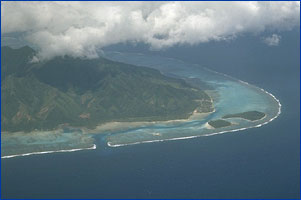The world's biomes
Biomes are defined as "the world's major communities, classified according to the predominant vegetation and characterized by adaptations of organisms to that particular environment" (Campbell 1996). The importance of biomes cannot be overestimated. Biomes have changed and moved many times during the history of life on Earth. More recently, human activities have drastically altered these communities. Thus, conservation and preservation of biomes should be a major concern to all. For further information, please consult the references page.
Here we group biomes into six major types:
 Freshwater |
 Marine |
 Desert |
 Forest |
 Grassland |
 Tundra |
Conservation and preservation of biomes

A coral reef surrounds an island in French Polynesia.
Forests are important as they are home to the most diverse biotic communties in the world. Hidden within these biomes are potential medicines and many thousands of unseen and undiscovered species. Also, forests have a global climate-buffering capacity, so their destruction may cause large-scale changes in global climate.
Logging has depleted many old-growth temperate forests. The increased demand for homes, paper, and other wood products have not allowed for much conservation. More recently, people have begun to realize that logging has cleared much of these forests. Wiser use of the forests and efforts to replant trees have helped to slow down the depletion of these communities.
Tropical forests have fallen victim to timber exploitation, slash and burn farming, and clearfelling for industrial use or cattle ranching, particularly in Latin America. Our increasing demand for meat products has spurred these events. For years, this destruction was occuring at a rapid rate. Over half of the world's original tropical forests are already gone. Public attention to this exploitation have helped to alleviate the problem somewhat, though many challenges are still to be faced.
The freshwater and marine biomes are probably the most important of all the biomes. Their medium, water, is a major natural resource. Water is the basis of life, it supports life, and countless species live in it for all or part of their lives. Freshwater biomes supply us with our drinking water and water for crop irrigation. The world's oceans have an even greater effect on global climate than forests do. Water has a high capacity for heat, and because the Earth is mostly covered with water, the temperature of the atmosphere is kept fairly constant and able to support life. In addition to this climate-buffering capacity, the oceans contain several billion photosynthetic plankton which account for most of the photosynthesis occuring on Earth. Without these, there might not be enough oxygen to support such a large world population and complex animal life.
Freshwater biomes have suffered mainly from pollution. Runoff containing fertilizer and other wastes and industrial dumpings enter into rivers, ponds, and lakes and tend to promote abnormally rapid algae growth. When these algae die, dead organic matter accumulates in the water. This makes the water unusable and it kills many of the organisms living in the habitat. Stricter laws have helped to slow down this thoughtless pollution.
Overfishing and pollution have threatened to make oceans into ecological disaster areas. Industrial pollutants that are dumped upstream of estuaries have rendered many marine habitats unsuitable for life. Again, tighter regulations have been used to prevent further destruction of the ocean biomes.
By educating people about the consequences of our actions, we can all gain a better understanding of how to preserve the Earth's natural biomes. The areas that have been destroyed the most will never regain their original forms, but conservation will help to keep them from getting worse.
--
The original biomes pages were created in fall 1996 by the Biomes Group, Biology 1B class, section 115, at UC Berkeley; all were reformatted, with many new photos added, in March, 2007. Coral reef photo by Marguerite Gregory © 2004 California Academy of Sciences. The pages were re-designed in 2019 as part of a general UCMP website overhaul. Unless noted, content on these pages have not been updated.